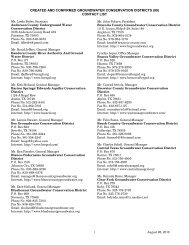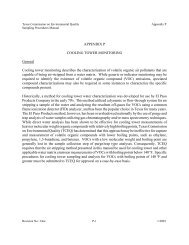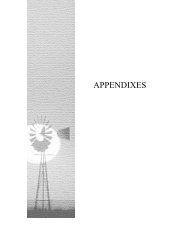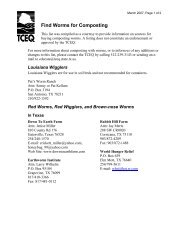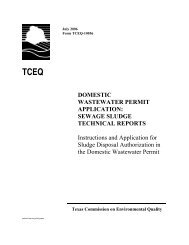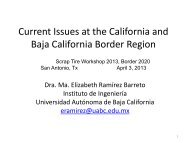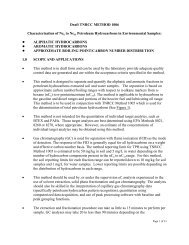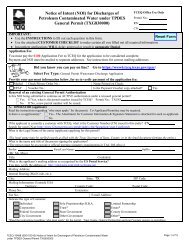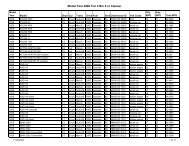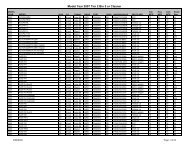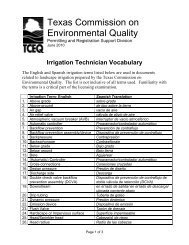joint groundwater report - Texas Commission on Environmental ...
joint groundwater report - Texas Commission on Environmental ...
joint groundwater report - Texas Commission on Environmental ...
You also want an ePaper? Increase the reach of your titles
YUMPU automatically turns print PDFs into web optimized ePapers that Google loves.
ability to remove or treat all c<strong>on</strong>taminants to background c<strong>on</strong>centrati<strong>on</strong>s. Ec<strong>on</strong>omic feasibilities include thehigh cost of sophisticated treatment technologies and the l<strong>on</strong>g time periods required to retrieve the affected<str<strong>on</strong>g>groundwater</str<strong>on</strong>g> for treatment. In many cases c<strong>on</strong>taminated <str<strong>on</strong>g>groundwater</str<strong>on</strong>g> cannot be restored to its original quality,and significant costs are incurred at many sites in the recovery and treatment of <str<strong>on</strong>g>groundwater</str<strong>on</strong>g>. It may not betechnically possible or cost-effective in all cases to clean <str<strong>on</strong>g>groundwater</str<strong>on</strong>g> to its original quality.Recognizing this situati<strong>on</strong>, the state's policy requires that <str<strong>on</strong>g>groundwater</str<strong>on</strong>g> be kept reas<strong>on</strong>ably free ofc<strong>on</strong>taminants that would interfere with present uses or impair future uses of <str<strong>on</strong>g>groundwater</str<strong>on</strong>g>. In resp<strong>on</strong>se, theTNRCC has developed an approach which focuses <strong>on</strong> protecti<strong>on</strong> of <str<strong>on</strong>g>groundwater</str<strong>on</strong>g> for high quality uses,including human health, and which addresses the cost of available remediati<strong>on</strong> technologies. The TNRCC,which has primary jurisdicti<strong>on</strong> for the regulatory protecti<strong>on</strong> of <str<strong>on</strong>g>groundwater</str<strong>on</strong>g>, is implementing a risk-basedapproach in setting cleanup levels that is based <strong>on</strong> sound science, flexibility, and comm<strong>on</strong> sense.This risk-based approach takes into c<strong>on</strong>siderati<strong>on</strong> the actual or reas<strong>on</strong>able potential for public andenvir<strong>on</strong>mental exposure to c<strong>on</strong>taminants in the determinati<strong>on</strong> of the timing, type, and degree of siteremediati<strong>on</strong>. Risk assessment is the process used to quantify the potential adverse effects to human health dueto exposure to chemicals. A risk assessment process was first proposed by the Nati<strong>on</strong>al Academy of Sciencein the 1983 publicati<strong>on</strong>: Risk Assessment in the Federal Government: Managing the Process. The basicprocess proposed by the Nati<strong>on</strong>al Academy of Science is the foundati<strong>on</strong> for most published risk assessmentguidance documents developed by state and federal regulatory agencies.The risk assessment process c<strong>on</strong>sists of four steps: hazard identificati<strong>on</strong>, dose-resp<strong>on</strong>se assessment,exposure assessment, and risk characterizati<strong>on</strong>. The objective of hazard identificati<strong>on</strong> is to determine whetherthe available chemical-specific scientific data describe a causal relati<strong>on</strong>ship between exposure to the chemicaland adverse human health effects. The dose-resp<strong>on</strong>se assessment quantifies the relati<strong>on</strong>ship between the dose(amount of chemical that the organism is exposed to) and the resp<strong>on</strong>se (adverse health effects). The objectiveof the exposure assessment is to analyze site-specific informati<strong>on</strong> to estimate the most likely dose to potentialhuman receptors. The risk characterizati<strong>on</strong> uses informati<strong>on</strong> from the previous three steps to estimate adversehuman health effects. The risk characterizati<strong>on</strong> answers the questi<strong>on</strong> "How much risk does the situati<strong>on</strong>pose?" This is followed by the risk management step which answers the questi<strong>on</strong> "What should be d<strong>on</strong>e withthe risk that has been quantified?"Depending <strong>on</strong> the level of the risk and the current regulatory policies, risk management may involve noacti<strong>on</strong>,engineering soluti<strong>on</strong>s such as soil and <str<strong>on</strong>g>groundwater</str<strong>on</strong>g> remediati<strong>on</strong>, or instituti<strong>on</strong>al c<strong>on</strong>trols such as deedrestricti<strong>on</strong>s or limiting access to the site. Thus, risk-based decisi<strong>on</strong>-making can be protective of human healthand the envir<strong>on</strong>ment, and offers a scientifically sound and administratively effective way to resp<strong>on</strong>d to thepressures for timely acti<strong>on</strong> at large numbers of sites and the efficient use of both public and private resources.The TNRCC's Office of Waste Management has incorporated risk-based corrective acti<strong>on</strong> into its rules andpolicies.The Groundwater Classificati<strong>on</strong> System has been incorporated into rules of the industrial solid wasteprogram of the Industrial and Hazardous Waste Divisi<strong>on</strong> and the Polluti<strong>on</strong> Cleanup Divisi<strong>on</strong> of the TNRCCfor closures and remediati<strong>on</strong>s of hazardous and n<strong>on</strong>-hazardous waste sites and areas of c<strong>on</strong>taminati<strong>on</strong>. Therules, known informally as the Risk Reducti<strong>on</strong> Rules, were promulgated in Title 30, <str<strong>on</strong>g>Texas</str<strong>on</strong>g> AdministrativeCode, Chapter 335, Subchapters A and S, with an effective date of June 28, 1993. These rules specify threerisk reducti<strong>on</strong> standards, or levels of cleanup, for c<strong>on</strong>taminated media including <str<strong>on</strong>g>groundwater</str<strong>on</strong>g>.Standard 1 calls for cleanup to background c<strong>on</strong>diti<strong>on</strong>s regardless of the <str<strong>on</strong>g>groundwater</str<strong>on</strong>g> classificati<strong>on</strong>. Standards2 and 3 allow for c<strong>on</strong>siderati<strong>on</strong> of the potential use of <str<strong>on</strong>g>groundwater</str<strong>on</strong>g> as a human drinking water resource based15



